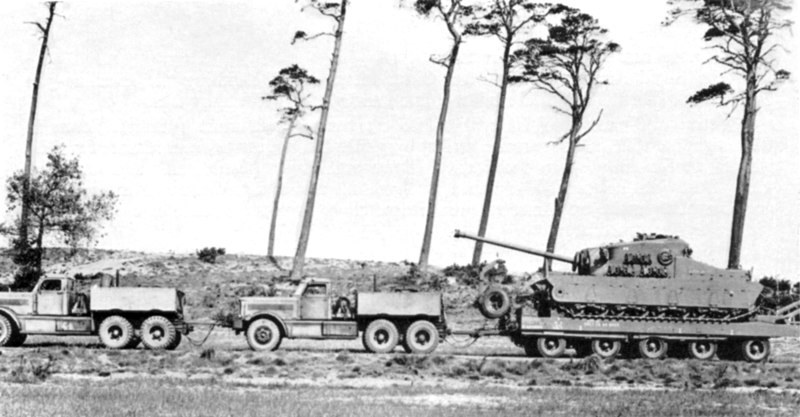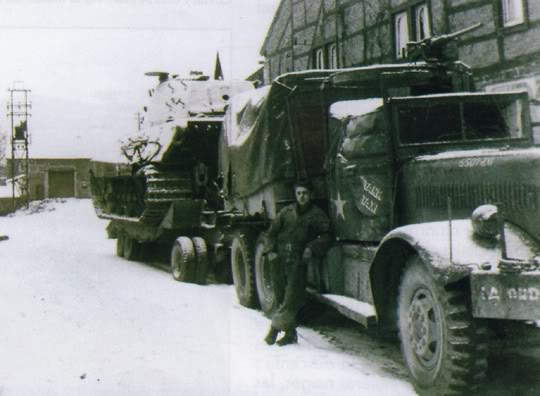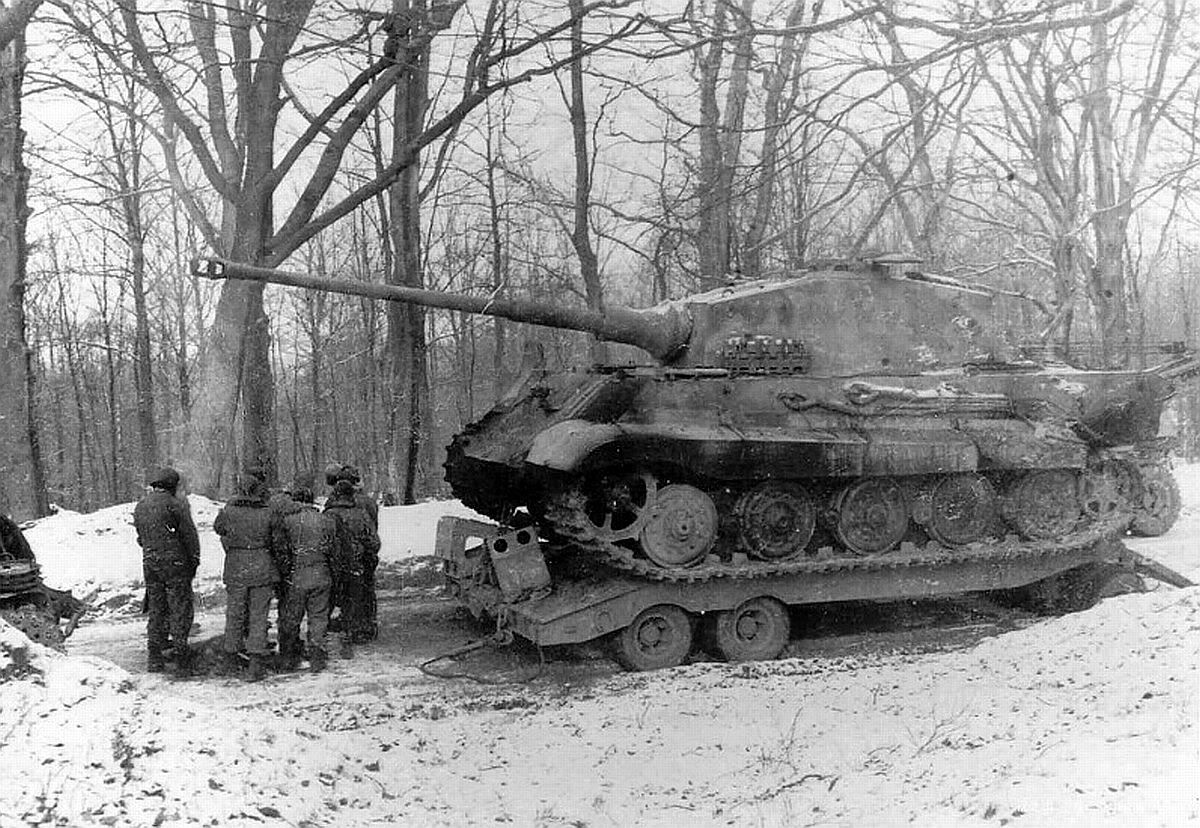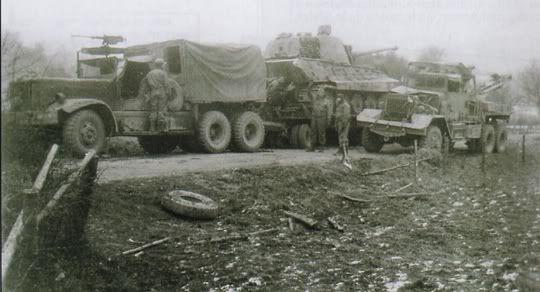Hosted by Darren Baker
Diamond T Tank Transporter Load Capacity ...
pbennett

Joined: October 14, 2007
KitMaker: 464 posts
Armorama: 412 posts
Posted: Wednesday, October 03, 2018 - 09:01 AM UTC
What would be the maximum load carried by the Diamond T Tank Transporter?

HeavyArty


Joined: May 16, 2002
KitMaker: 17,694 posts
Armorama: 13,742 posts

Posted: Wednesday, October 03, 2018 - 09:11 AM UTC
The load capacity of the trailer was 45 tons. It could carry pretty much any Allied or German tank, except maybe the Tiger series tanks.

m4sherman

Joined: January 18, 2006
KitMaker: 1,866 posts
Armorama: 1,808 posts

Posted: Wednesday, October 03, 2018 - 01:09 PM UTC
Gino pretty much summed it up.
The tractor was used to pull a heavy trailer with the Tiger II loaded (ex Pieper), that was sent back to the US after being captured during the Bulge fighting.
The tractor was used to pull a heavy trailer with the Tiger II loaded (ex Pieper), that was sent back to the US after being captured during the Bulge fighting.
GaryKato

Joined: December 06, 2004
KitMaker: 3,694 posts
Armorama: 2,693 posts

Posted: Wednesday, October 03, 2018 - 03:26 PM UTC
There is a picture in Squadron's "M19-M20 Tank Transporter Detail in Action" with 2 M20 tractors hitched in tandem pulling a trailer with a British Tortoise.

RobinNilsson

Joined: November 29, 2006
KitMaker: 6,693 posts
Armorama: 5,562 posts

Posted: Wednesday, October 03, 2018 - 07:43 PM UTC
Quoted Text
There is a picture in Squadron's "M19-M20 Tank Transporter Detail in Action" with 2 M20 tractors hitched in tandem pulling a trailer with a British Tortoise.
This one?

Different trailer with a higher load rating ....
/ Robin

ReluctantRenegade

Joined: March 09, 2016
KitMaker: 2,408 posts
Armorama: 2,300 posts

Posted: Wednesday, October 03, 2018 - 09:19 PM UTC
Quoted Text
What would be the maximum load carried by the Diamond T Tank Transporter?
The IDF used the Diamond T tractor/Rogers trailer setup for hauling its heavy equipment, including Shot tanks - and those were over 50 tons, even in their basic configuration. Having said that, that was probably beyond the maximal weight this setup was optimized for.

pbennett

Joined: October 14, 2007
KitMaker: 464 posts
Armorama: 412 posts
Posted: Wednesday, October 03, 2018 - 09:53 PM UTC
Many thanks!
covkid

Joined: March 13, 2015
KitMaker: 252 posts
Armorama: 194 posts
Posted: Thursday, October 04, 2018 - 01:30 AM UTC
During the battle Bulge the US army recovered a King Tiger using a Diamond T and Rogers trailer.
As a side note, in UK service it was rated at 40 tons. This is because a UK ton is 2200 pounds, slightly more than a metric ton and a US ton is 2000 pounds.
Regards Jason
As a side note, in UK service it was rated at 40 tons. This is because a UK ton is 2200 pounds, slightly more than a metric ton and a US ton is 2000 pounds.
Regards Jason

ReluctantRenegade

Joined: March 09, 2016
KitMaker: 2,408 posts
Armorama: 2,300 posts

Posted: Thursday, October 04, 2018 - 01:41 AM UTC
Quoted Text
This is because a UK ton is 2200 pounds, slightly more than a metric ton and a US ton is 2000 pounds.
Good to know, had no idea about that.

Frenchy

Joined: December 02, 2002
KitMaker: 12,719 posts
Armorama: 12,507 posts

Posted: Thursday, October 04, 2018 - 01:43 AM UTC
Quoted Text
During the battle Bulge the US army recovered a King Tiger using a Diamond T and Rogers trailer.


H.P.

RobinNilsson

Joined: November 29, 2006
KitMaker: 6,693 posts
Armorama: 5,562 posts

Posted: Thursday, October 04, 2018 - 01:52 AM UTC
Quoted Text
Quoted TextThis is because a UK ton is 2200 pounds, slightly more than a metric ton and a US ton is 2000 pounds.
Good to know, had no idea about that.
It is an Anglo-American conspiracy to keep us foreigners confused regarding weights and capacity of their military equipment.
They also confuse each other by using different sizes of gallons, for instance when measuring fuel.
A US made car will get more miles per gallon in the UK than in the US since the British gallon is larger (1 imperial gallon is approximately 1.2 US gallon ....)
They have the same size of inches, feet and yards though.
/ Robin

m4sherman

Joined: January 18, 2006
KitMaker: 1,866 posts
Armorama: 1,808 posts

Posted: Thursday, October 04, 2018 - 07:28 AM UTC
Quoted Text
Quoted TextDuring the battle Bulge the US army recovered a King Tiger using a Diamond T and Rogers trailer.

H.P.
Frenchy, I looked all over for that lower picture. All I could find were the ones of the heavy trailer. There was a feature article in the MVPA or the After the Battle series about the recovery. From what I remember they had a lot of tires blow out.
philhendry

Joined: December 26, 2009
KitMaker: 57 posts
Armorama: 56 posts
Posted: Thursday, October 04, 2018 - 09:32 AM UTC
Actually, a UK ton is 2240 lb, rather than 2200. A ton is 20 cwt where 1 hundredweight is 112lb. It does all, sort of, make sense... To a lunatic.

Frenchy

Joined: December 02, 2002
KitMaker: 12,719 posts
Armorama: 12,507 posts

Posted: Thursday, October 04, 2018 - 10:22 AM UTC

RobinNilsson

Joined: November 29, 2006
KitMaker: 6,693 posts
Armorama: 5,562 posts

Posted: Thursday, October 04, 2018 - 10:53 AM UTC
Quoted Text
Actually, a UK ton is 2240 lb, rather than 2200. A ton is 20 cwt where 1 hundredweight is 112lb. It does all, sort of, make sense... To a lunatic.
Where does stones fit into this mess?
It amazes me that a ton is 20 cwt, wouldn't it have been more in line with the other odd numbers to let a ton by 19 or 21 cwt instead?
/ Robin

smydi01

Joined: October 14, 2009
KitMaker: 219 posts
Armorama: 197 posts

Posted: Thursday, October 04, 2018 - 11:26 AM UTC
Quoted Text
Quoted TextActually, a UK ton is 2240 lb, rather than 2200. A ton is 20 cwt where 1 hundredweight is 112lb. It does all, sort of, make sense... To a lunatic.
Where does stones fit into this mess?
It amazes me that a ton is 20 cwt, wouldn't it have been more in line with the other odd numbers to let a ton by 19 or 21 cwt instead?
/ Robin
A stone is fourteen pounds. I don't know why.

Posted: Thursday, October 04, 2018 - 11:32 AM UTC
Quoted Text
Quoted TextActually, a UK ton is 2240 lb, rather than 2200. A ton is 20 cwt where 1 hundredweight is 112lb. It does all, sort of, make sense... To a lunatic.
Where does stones fit into this mess?
It amazes me that a ton is 20 cwt, wouldn't it have been more in line with the other odd numbers to let a ton by 19 or 21 cwt instead?
/ Robin
Well a stone is 14 pound which means a CWT is 8 stone, so a ton is 160 stone.
Metric does have it's good point's after all

This may help to explain where the measurements came from and why the US measurements are different.
The Weights and Measures Act of 1824 and the Act of 1878 established the British Imperial System on the basis of precise definitions of selected existing units. The 1824 act sanctioned a single imperial gallon to replace the wine, ale, and corn (wheat) gallons then in general use. The new gallon was defined as equal in volume to 10 pounds avoirdupois of distilled water weighed at 62 °F with the barometer at 30 inches, or 277.274 cubic inches (later corrected to 277.421 cubic inches). The two new basic standard units were the imperial standard yard and the troy pound, which was later restricted to weighing drugs, precious metals, and jewels. A 1963 act abolished such archaic measures as the rod and chaldron (a measure of coal equal to 36 bushels) and redefined the standard yard and pound as 0.9144 metres and 0.45359237 kg respectively. The gallon now equals the space occupied by 10 pounds of distilled water of density 0.998859 gram per millilitre weighed in air of density 0.001217 gram per millilitre against weights of density 8.136 grams per millilitre.
While the British were reforming their weights and measures in the 19th century, the Americans were just adopting units based on those discarded by the act of 1824. The standard U.S. gallon is based on the Queen Anne wine gallon of 231 cubic inches and is about 17 percent smaller than the British imperial gallon. The U.S. bushel of 2,150.42 cubic inches, derived from the Winchester bushel abandoned in Britain, is approximately 3 percent smaller than the British imperial bushel. In the British system, units of dry and liquid capacity are the same, while in the United States they differ; the liquid and dry pint in Britain both equal 0.568 cubic decimetre, while the U.S. liquid pint is 0.473 cubic decimetre, and the U.S. dry pint is 0.551 cubic decimetre. British and American units of linear measure and weight are essentially the same. Notable exceptions are the British stone of 14 pounds, which is not used in the United States, and a divergence in definition of the hundredweight (100 pounds in the United States, 112 in Britain) that yields two different tons, the short U.S. ton of 2,000 pounds and the long British ton of 2,240 pounds. In 1959 major English-speaking nations adopted common metric definitions of the inch (2.54 cm), the yard (0.9144 metres), and the pound (0.4536 kg).
Interesting to know that the inch is the lenght it is as it is equal to the length of three barleycorns and stems from the 14th century.

Frenchy

Joined: December 02, 2002
KitMaker: 12,719 posts
Armorama: 12,507 posts

Posted: Thursday, October 04, 2018 - 06:04 PM UTC
Any other ton expert wanting to weigh in ? 
H.P.

H.P.

RobinNilsson

Joined: November 29, 2006
KitMaker: 6,693 posts
Armorama: 5,562 posts

Posted: Thursday, October 04, 2018 - 07:03 PM UTC
Quoted Text
Any other ton expert wanting to weigh in ?
H.P.
The French Revolution eventually led to the metric system so the parts of the world who have got a sensible system for measurements can thank the French revolutionaries for it

The metric clock and the new calendar didn't catch on though ...
https://en.wikipedia.org/wiki/French_Republican_Calendar
/ Robin

m4sherman

Joined: January 18, 2006
KitMaker: 1,866 posts
Armorama: 1,808 posts

Posted: Friday, October 05, 2018 - 03:54 AM UTC
Great, so I can blame the French for the first car I owned! It was assembled in Canada by Dodge. The entire chassis was standard, but the engine and some interior parts were metric. So that's how I came to learn metric.

RobinNilsson

Joined: November 29, 2006
KitMaker: 6,693 posts
Armorama: 5,562 posts

Posted: Friday, October 05, 2018 - 04:00 AM UTC
Quoted Text
Great, so I can blame the French for the first car I owned! It was assembled in Canada by Dodge. The entire chassis was standard, but the engine and some interior parts were metric. So that's how I came to learn metric.
Great fun can be had by adding a few non-metric screws to the tins where someone working on some mechanic contraption keeps the metric screws removed from the object. Sometimes it is enough to just add a few screws of the same dimensions and watch them search for the screwholes to fit the superfluous screws ...
/ Robin
Posted: Friday, October 05, 2018 - 06:09 AM UTC
Added to all of these weighty matters...
Is that, I do believe, the rated load capacity for both American and Commonwealth trucks and trailers is the rough field capacity. The hard pavement capacity being approximately double.
So, a 2.5 ton truck can haul 2.5 tons cross country or 5 tons on pavement only.
Therefore, a Rogers 40 ton trailer could haul 80 tons on capable paved roads.
Is that, I do believe, the rated load capacity for both American and Commonwealth trucks and trailers is the rough field capacity. The hard pavement capacity being approximately double.
So, a 2.5 ton truck can haul 2.5 tons cross country or 5 tons on pavement only.
Therefore, a Rogers 40 ton trailer could haul 80 tons on capable paved roads.
pbennett

Joined: October 14, 2007
KitMaker: 464 posts
Armorama: 412 posts
Posted: Friday, October 05, 2018 - 06:23 AM UTC
I had no idea that my simple question would provoke such an extensive debate ... most informative, nonetheless.

m4sherman

Joined: January 18, 2006
KitMaker: 1,866 posts
Armorama: 1,808 posts

Posted: Friday, October 05, 2018 - 06:52 AM UTC
Quoted Text
Quoted TextGreat, so I can blame the French for the first car I owned! It was assembled in Canada by Dodge. The entire chassis was standard, but the engine and some interior parts were metric. So that's how I came to learn metric.
Great fun can be had by adding a few non-metric screws to the tins where someone working on some mechanic contraption keeps the metric screws removed from the object. Sometimes it is enough to just add a few screws of the same dimensions and watch them search for the screwholes to fit the superfluous screws ...
/ Robin
I know how it feels to put an assembly back together and find extra screws, so you must be moonlighting at my job!

m4sherman

Joined: January 18, 2006
KitMaker: 1,866 posts
Armorama: 1,808 posts

Posted: Friday, October 05, 2018 - 06:59 AM UTC
Quoted Text
Added to all of these weighty matters...
Is that, I do believe, the rated load capacity for both American and Commonwealth trucks and trailers is the rough field capacity. The hard pavement capacity being approximately double.
So, a 2.5 ton truck can haul 2.5 tons cross country or 5 tons on pavement only.
Therefore, a Rogers 40 ton trailer could haul 80 tons on capable paved roads.
I have a 1/2 ton Dodge weapons carrier (not running) and it was based on a 1 ton Dodge truck. I was told by a Dodge enthusiest that the Army halved the load rating for safety purposes. I never confirmed that, but it ties in with your post.
 |















